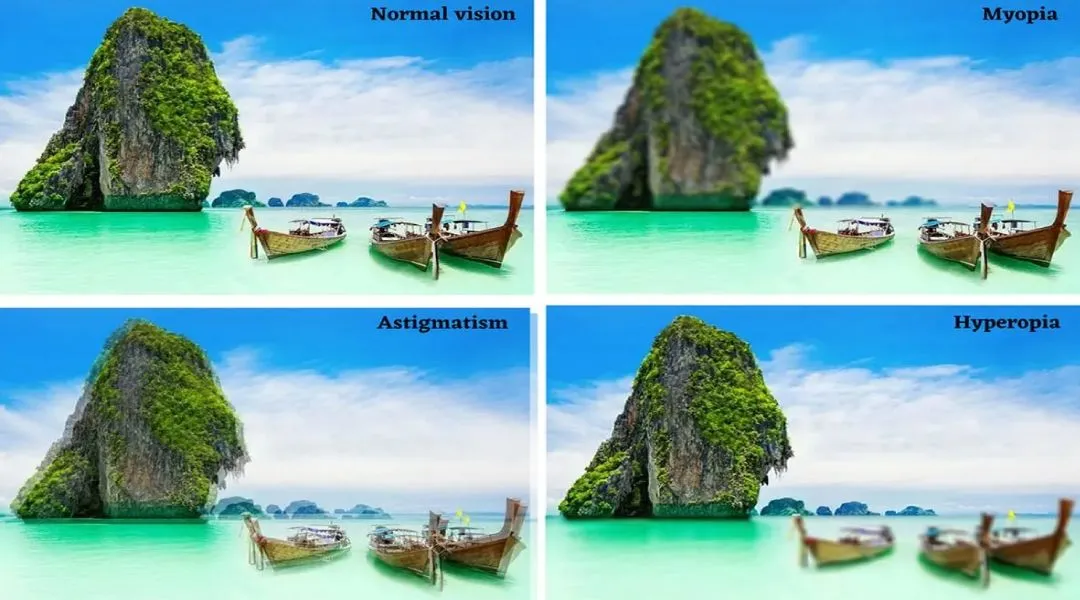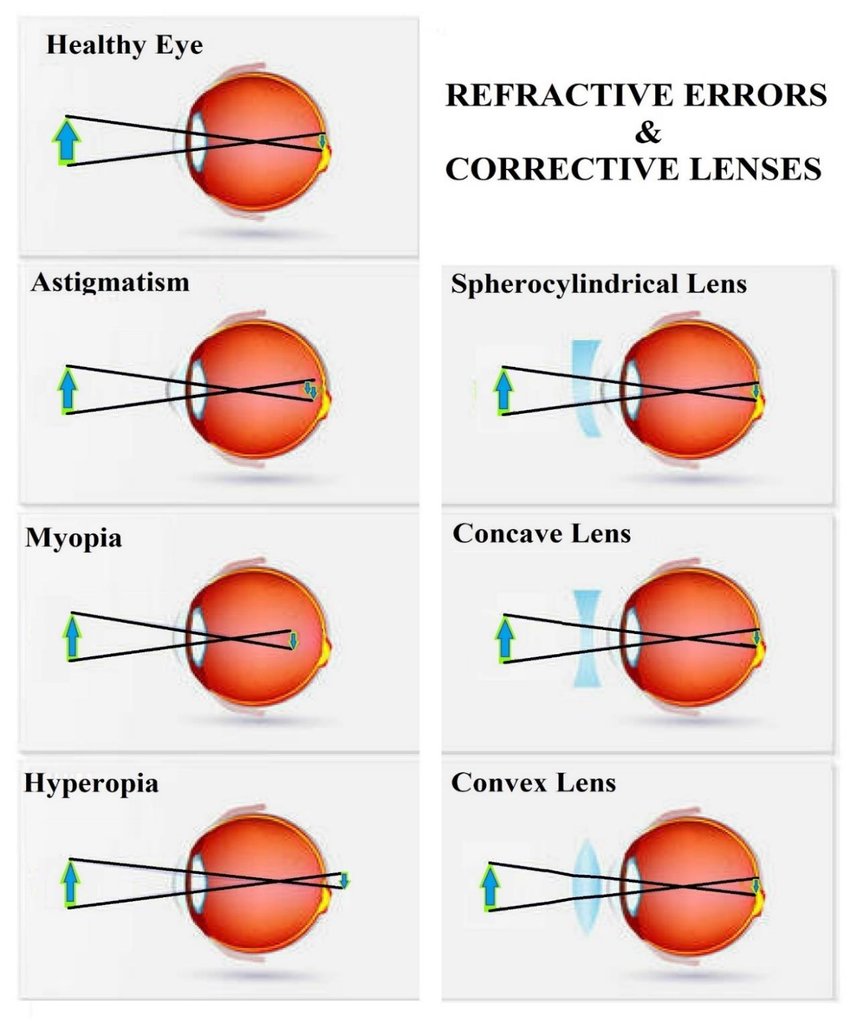What Are Refractive Errors?
Refractive errors occur when the eye cannot properly focus light onto the macula — the central region of the retina responsible for sharp vision. When light is not focused precisely, images appear blurry, distorted, or lack detail.

Comparison between normal vision and refractive error types
Refractive errors are not diseases but common optical disorders. According to the World Health Organization (WHO), about 2.2 billion people worldwide suffer from vision loss caused by refractive errors — most of which are correctable with glasses or modern refractive surgery.
Common symptoms include:
- Blurred vision at near or far distances
- Squinting to see clearly
- Eye strain or headaches after prolonged tasks
- Poor night vision or difficulty adapting to light changes
The most common types include: myopia, hyperopia, astigmatism, and presbyopia. Many individuals may have a combination (e.g., myopia + astigmatism).
Types of Refractive Errors and Their Optical Features

Light focusing patterns and corrective lenses for each refractive error
Refractive errors are classified by where light rays focus after passing through the cornea, lens, and vitreous. Each has a unique light-bending mechanism, leading to distinct visual symptoms.
| Type | Optical Description | Typical Symptoms |
|---|---|---|
| Myopia (Nearsightedness) | Light focuses in front of the retina due to a long eyeball or steep cornea | Clear near vision, blurred distance vision; night driving difficulty |
| Hyperopia (Farsightedness) | Light focuses behind the retina due to a short eyeball or flat cornea | Blurred near vision, eye fatigue, headaches when reading |
| Astigmatism | Uneven light refraction due to irregular curvature of cornea or lens | Blurred or distorted vision, halos around lights, eye fatigue |
| Presbyopia | Age-related lens stiffening, impairing near focus | Difficulty reading; need to hold text farther away |
🔎 Note: People may experience multiple refractive errors at once — e.g., myopia + astigmatism — requiring accurate diagnosis and customized treatment.
Understanding each error’s optical nature is key to selecting appropriate treatments — from glasses and contacts to modern procedures like LASIK, SMILE, PRK, or Phakic ICL.
What Causes Refractive Errors?
- Genetics: Family history of myopia or astigmatism increases risk
- Visual habits: Prolonged screen time or close work
- Lighting conditions: Poor natural light or dim environments
- Abnormal eye structure: Irregular cornea or lens shape
- Aging: Natural stiffening of the lens (presbyopia)
Refractive Error Treatment Options

Illustration of Phakic ICL lens placement between iris and natural lens
a. Eyewear
- Eyeglasses: Safe, easy, suitable for all ages
- Contact lenses: More aesthetic, great for active individuals; requires good hygiene
b. Refractive Surgery
| Method | Mechanism | Best For |
|---|---|---|
| LASIK | Laser reshaping of the cornea via flap | People with thick corneas and moderate–high myopia |
| SMILE | Tissue removal via small incision, flapless | People with thin corneas or prone to dry eyes |
| PRK/LASEK | Epithelium removal, laser applied directly | Moderate myopia with thinner corneas |
| Phakic ICL | Implantable Collamer lens behind iris | High myopia, thin corneas, cornea-preserving solution |
Treatment by Age and Lifestyle
| Target Group | Suggested Options |
|---|---|
| Students | Eyeglasses, contact lenses |
| Office workers | SMILE, LASIK, or Phakic ICL for thin corneas |
| Athletes or frequent travelers | Phakic ICL, SMILE |
| Middle-aged and older adults | RLE (Refractive Lens Exchange), multifocal glasses |
Conclusion
Refractive errors are common but highly treatable. Early diagnosis and appropriate correction can significantly improve vision and quality of life. Don’t overlook advanced solutions like Phakic ICL — ideal for those seeking long-lasting clarity without compromising corneal health. Visit an eye specialist regularly to preserve your vision for the future.

 vi
vi 24-Jun-2025
24-Jun-2025











 0916.741.763
0916.741.763 Appointment
Appointment